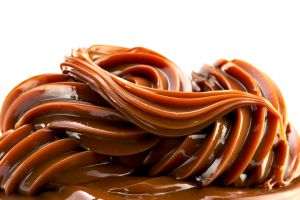Differences between Cajeta and Dulce de Leche
From diff.wiki
Revision as of 14:11, 14 August 2020 by BelemMar (talk | contribs) (Created page with "thumb|left|Cajeta or dulce de leche Both cajeta and dulce de leche are Latin American sweets. These desserts are physically very similar to...")
Both cajeta and dulce de leche are Latin American sweets. These desserts are physically very similar to caramel; however their flavor, although sweet, is different from that of the caramel. Most people have the belief that since cajeta is from Mexico and dulce de leche from down south (Chile-Argentina), they are different desserts. However they are more similar than they appear. As a matter of fact, the main (sometimes the only) difference between them is the origin of the milk they are made from.
| Cajeta | Dulce de leche | |
|---|---|---|
| Where is it from? | Cajeta is from Mexico. To be more specific, it comes from the Bajío, the West North- Central region of Mexico. It is believed that during the Viceroyalty (Virreinato) period cajeta began to be produced, after the original recipe arrived all the way from Spain. Nevertheless, a very important ingredient had to be changed. While the original recipe included cow milk as its main ingredient, the Mexican variation had to replace it with goat milk. Since cows were hardly ever found in this region and goats were very popular, it seemed like the adequate thing to do. That is how the cajeta that most people know nowadays was created. | As a matter of fact, there are no straight records of the creation of this dessert. Nevertheless, we know it was created in South America. Some people are convinced that dulce de leche was invented in Chile, as a filling ingredient for alfajores, a Hispanic dessert. From Chile it supposedly arrived into Argentina, where it quickly became popular. Other countries such as Paraguay, Brazil and Uruguay have also claimed the invention of dulce de leche. What is most likely to have happened actually, is the arrival of an Indonesian recipe for a caramel-like sweet to several American countries at the same time, which resulted in the creation of dulce de leche. |
| Where is it consumed? | All over Mexico, in some parts of the United States and even Belize, Guatemala and Honduras amongst others. | Dulce de leche is widely consumed in South America. To name a few countries Argentina, Chile, Brazil, Uruguay, Paraguay and Colombia are amongst the top consumers of this dessert. |
| What kind of milk does it use? | Goat milk | Cow milk |
| Other names | Dulce de leche (not used in Mexico), cajeta de Celaya. | Manjar, manjar blanco, arequipe and cajeta. In France it is called confiture du lait. In Brazil is doce de leite. |
| Ingredients | Besides goat milk, brown sugar and cinnamon are used. | Cow milk, sugar, vanilla essence and baking soda. |
| Uses | Cajeta is used in a variety of pies, cakes, crepes, pastries, ice creams and milkshakes. Also on top of hot cakes, waffles, and French toasts. | On the other hand, dulce de leche is used as alfajores filling, in waffers, cakes, cuchuflíes, brigadeiros, and many others. |
